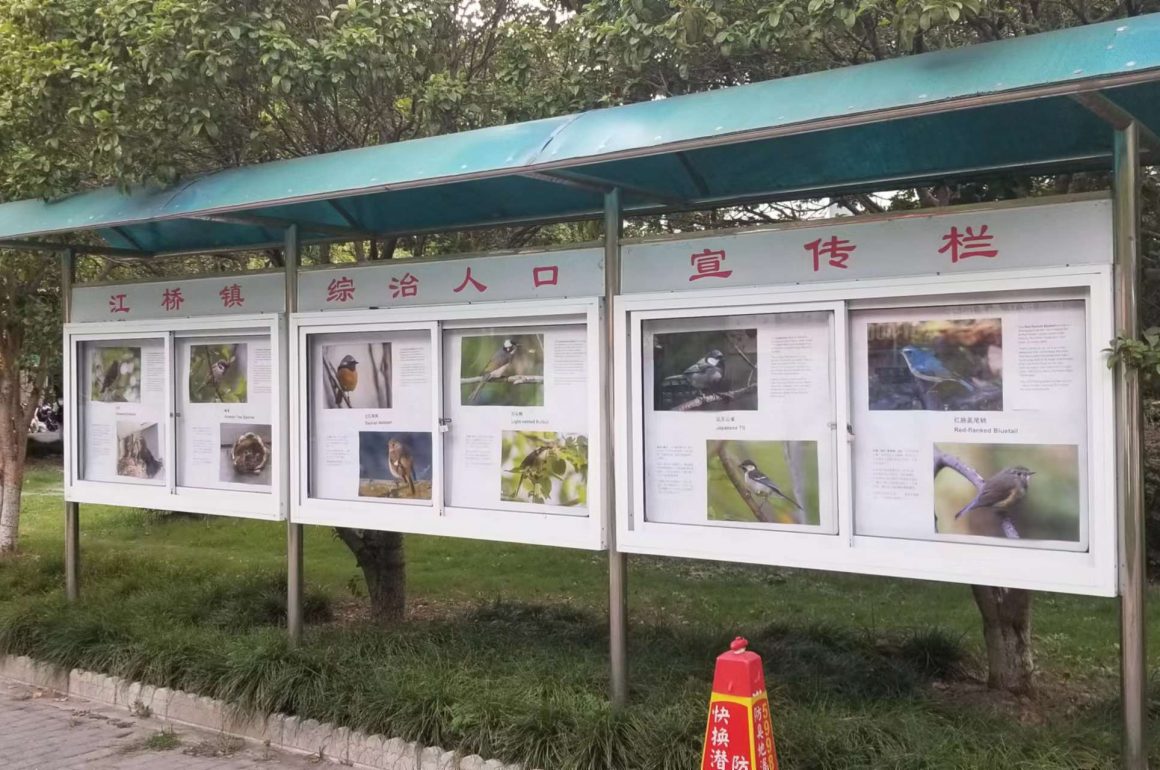
For some reason that I do not quite understand myself – given that I really rather dislike children and am not too positive about the rest of humanity either – I recently put up a little display of bird photos inside my Shanghai compound, which I share (as the only foreigner) with about 1700 Chinese.
So, here are the photos including a few comments, showing species that can actually be seen in this suburban compound – incidentally (as one friend pointed out) in the same glass boxes usually used for propaganda posters (of course I asked for the ok from the local government officials and in addition, made sure none of the bird species shown had ever made any public negative remarks about the Chinese Communist Party).
Pretty pointless, I agree – but if only one of the kids looking at the photos wins a Nobel Prize for Bird Conservation 50 years later, it was all worth it (though in the words of Dave Barry, I plan to be dead by then).
Here are a few photos of the real-life display:
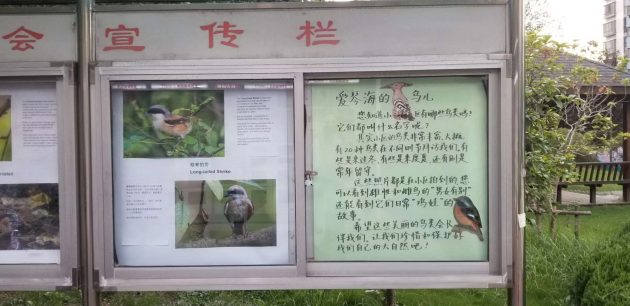
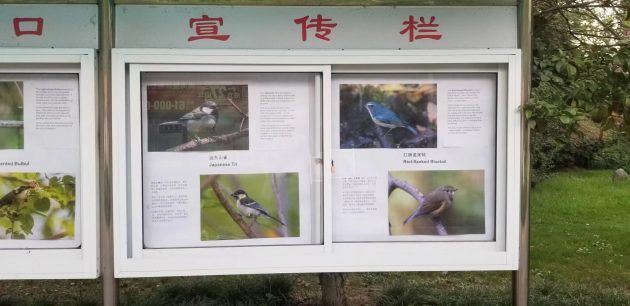
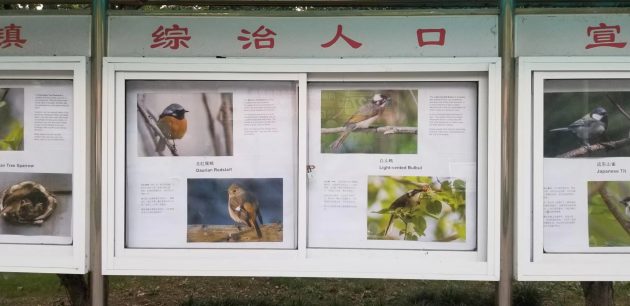
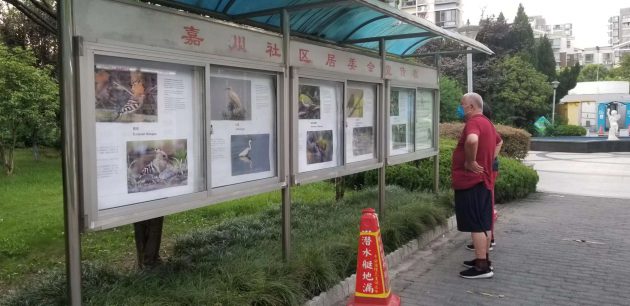
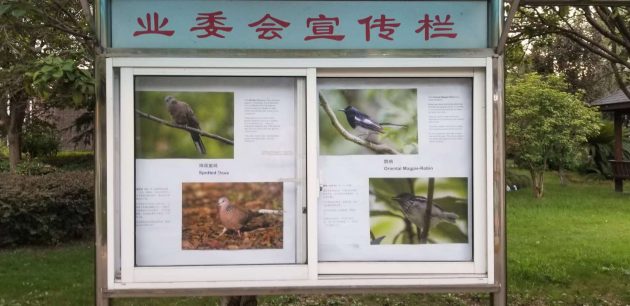
And here are the photos I showed, with some short and fairly irrelevant explanations, converted to a stand-alone presentation. As this was prepared for local use, I left out the English text and bird names – everything is in Chinese. But before you start complaining – keep in mind that you are in this situation for a few seconds now while for me, it has been more than 18 years. And I have added the English text and bird name after each illustration, a luxury I never have here.
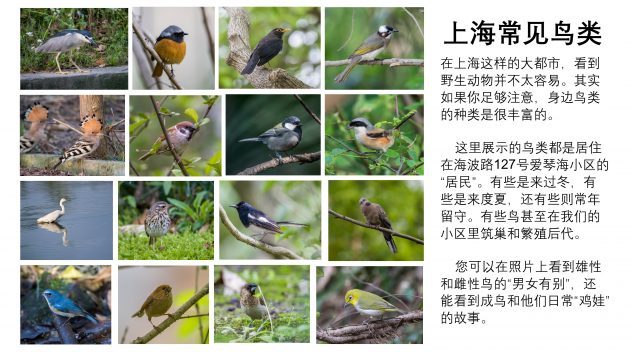
Some Birds of Shanghai
In a big city such as Shanghai, it is not always easy to see animals. But luckily, it is still relatively easy to see birds, if you pay enough attention. The photos and descriptions you can see in this little exhibition are all of birds that sometimes come to our compound at 127 Haibo Road. Some only live here in winter, others only in summer, while some can be seen all year round. Some are even building nests and having chicks here inside our compound. In the photos, you can see sometimes male and female (these two can look quite different), for others, baby and adult birds.
China is developing very fast, and Shanghai is developing even faster. This sometimes makes it difficult for wild animals to survive. Hopefully, seeing these birds and learning about them will also make you understand that it is important to protect them and nature in general.
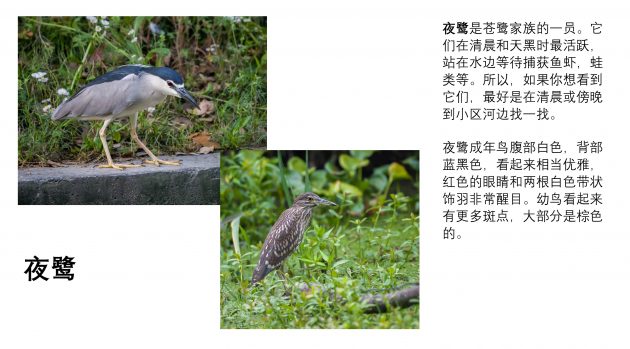
The Black-crowned Night Heron is a member of the heron family. It is related to the Little Egret that also visits our compound. These birds are most active early in the morning and when it gets dark. At that time, they stand somewhere in or near the water and wait for fish to catch. So, if you want to see them, the best chances are early in the morning at the little river at the back of the compound. The adult birds look quite elegant in white and blueish-black, with red eyes and two white napes. The juveniles look spottier and are mostly brown.
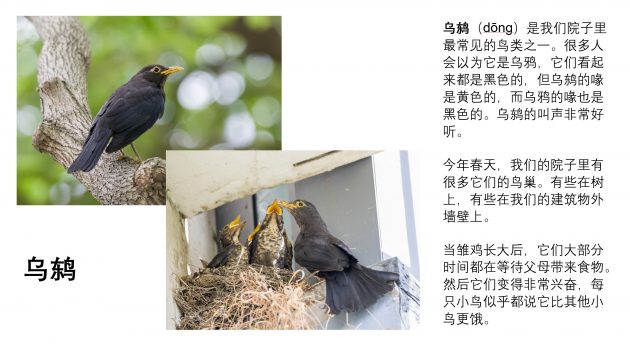
The Chinese Blackbird is among the most common birds in our compound. They are also among the noisiest and give an alarm sound when they feel somebody gets too close to them. This spring, we had many nests of these birds in our compound. Some were on trees, others outside on some of our buildings. When the chicks grow up, they spend most of their time waiting for their parents to fly back to them and bring them food. They then get very excited, and every chick seems to say it is hungrier than the others.
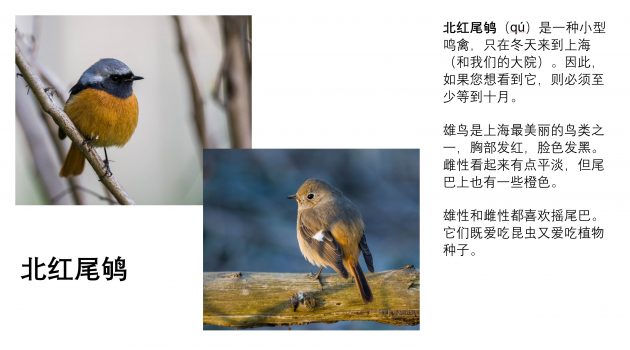
The Daurian Redstart is a small songbird that only comes to Shanghai (and our compound) in winter. So if you want to see it, you have to wait at least until October. The male bird is among the most beautiful birds in Shanghai with its reddish breast and black face. The female is a bit plainer but also has some orange color on its tail. Both the male and the female like to shake their tail. They eat both insects and seeds.
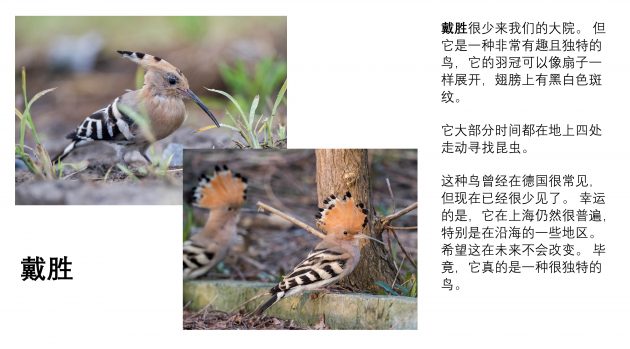
The Eurasian Hoopoe only rarely comes to our compound. But it is a very interesting-looking and unique bird with its crest and its combination of black, white, and cinnamon colors. It spends most of the time walking around on the ground looking for insects. This bird used to be quite common in Germany, but now it is rare. Fortunately, it is still quite common in Shanghai, particularly in some areas near the coast. Hopefully, this will not change in the future. After all, it really is a very special bird.
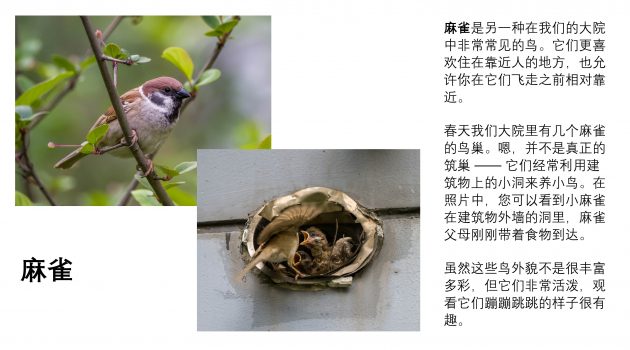
The Eurasian Tree Sparrow is another bird that is very common in our compound. This bird rather likes to live close to people, and also lets you get relatively close before they fly away. In spring, we had several nests of the bird in our compound. Well, not really nests – the bird often uses little holes in buildings to bring up its chicks. In the photo, you can see some chicks in such a hole outside of one of our buildings, with a parent just arriving with food. While these birds are not very colorful, they are very lively and active, and it is fun to watch them.
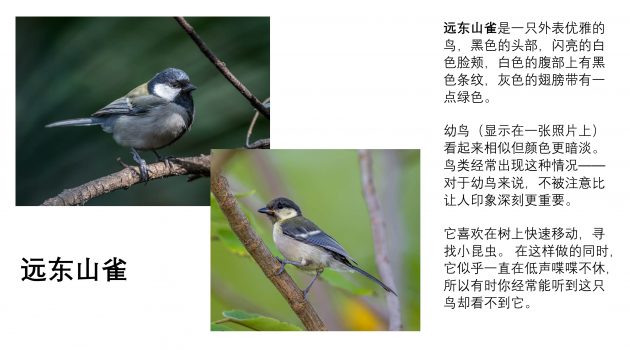
The Japanese Tit is an elegant-looking bird with a flashy white cheek on a black head, a black stripe on a white belly, and gray wings with a bit of green. The young birds (shown in one photo) look similar but duller. This is often the case in birds – for the young birds, it is more important to be invisible than to impress the other birds of the same species. It likes to quickly move around in trees looking for small insects. While doing this, it seems to be constantly chattering in a low voice, so it is sometimes easier to hear this bird than to see it.

The Light-vented Bulbul is probably the noisiest bird in our compound, and also one of the most common. It is lucky that this is also a rather attractive bird, with its combination of white, black, and greenish color In our compound, they are easy to see – they seem to be everywhere. Whenever there is some tree with fruit, they frequently go there to eat. But they also eat insects. Some people think that this bird is the bird that is the most characteristic of the city of Shanghai.
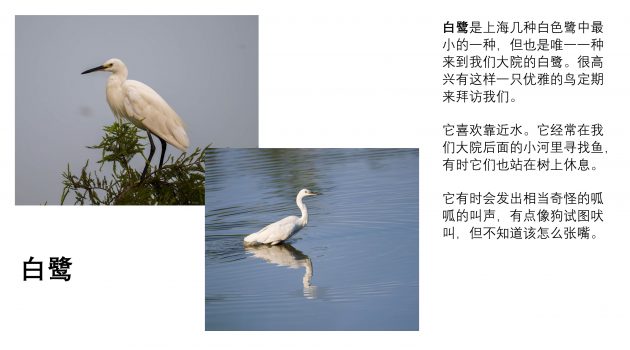
The Little Egret is the smallest of several white egrets that one can see in Shanghai, but the only one that comes to our compound. It is nice to have such an elegant-looking bird visiting us regularly. This bird likes to stay close to water. It often looks for fish in the little river at the back of our compound, or it rests on a tree. It sometimes makes a rather strange croaking noise, a bit as if a dog tries to bark but does not know how to do it properly.
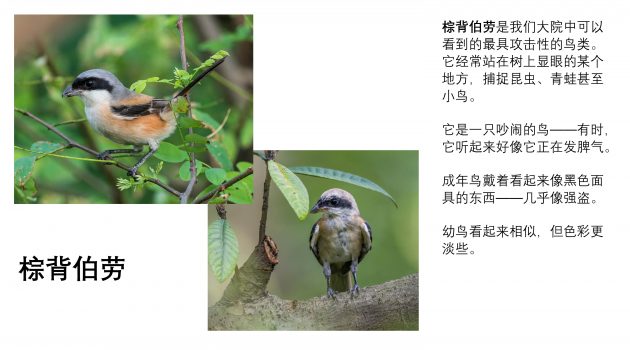
The Long-tailed Shrike is the most aggressive bird that can be seen in our compound. It often sits somewhere exposed on a tree, watching for insects, frogs, or even small birds to catch. It is a noisy bird – sometimes, it sounds as if the bird is very angry. The adult bird wears what looks like a black face mask – almost like a bandit. Above this mask, the bird is grey; below, it is white and orange-brown. The juvenile looks similar, but as often with juvenile birds, the colors are weaker.
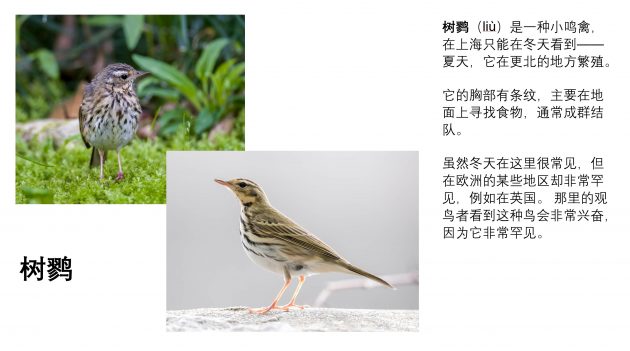
The Olive-backed Pipit is a small songbird that in Shanghai can only be seen in winter – in summer, it breeds further north. It has a streaked breast and mostly looks for food on the ground, often in small flocks While it is common around here in winter, it is very rare in some parts of Europe, for example in Britain. Birdwatchers there get very excited about seeing this bird as it is so rare.
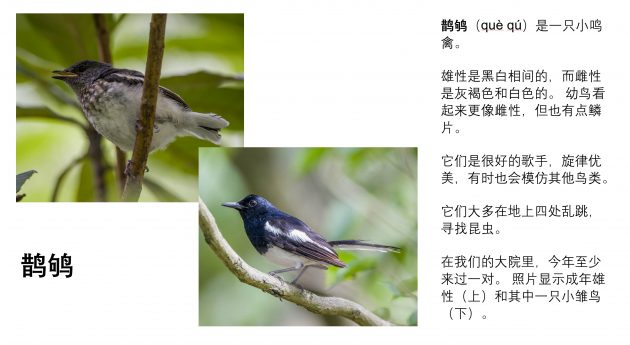
The Oriental Magpie-Robin is a small songbird. Males are black-and-white while the females are grayish brown and white. Young birds look more like females but are also a bit scaly. They are good singers with nice melodies and sometimes also imitate other birds. They eat insects, which they mostly find hopping around on the ground. In our compound, we have at least one pair this year. The photos show the adult male and one of the chicks.
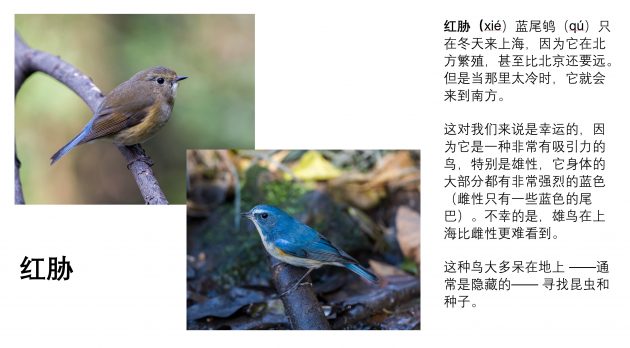
The Red-flanked Bluetail is only in Shanghai in winter, as it breeds far further North – even further than Beijing. But when it gets too cold there, it comes here. That is lucky for us, as it is a very attractive bird, particularly the male that has a very intensive blue color on a large part of its body (the female only has some blue on the tail). Unfortunately, the male bird is much more difficult to see in Shanghai than the female. This bird mostly stays on the ground – often hidden – looking for insects but also some seeds.
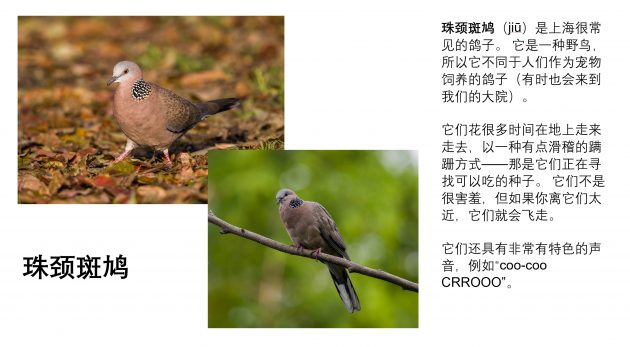
The Spotted Dove is a very common pigeon in Shanghai. It is a wild bird, so it is different from the pigeons which are kept by people as pets (which sometimes also come to our compound). They spend a lot of time on the ground walking around in a slightly funny waddling way – they are looking for seeds to eat. They are not very shy but will fly off if you get too close to them. They also have a very characteristic sound, something like “coo-coo CRROOO”.
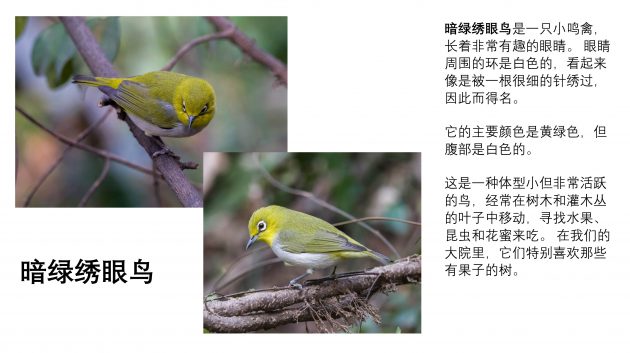
Swinhoe’s White-eye is a small songbird with a very interesting-looking eye. The ring around the eye is white and looks like it has been embroidered by a very fine needle, which gives the bird its Chinese name. Its main color is yellow-greenish, but the belly is white. This is a small but very active bird that moves around a lot among the leaves of trees and bushes, searching for fruit, insects, and nectar to eat. In our compound, they particularly like some of the trees when those trees have fruit.
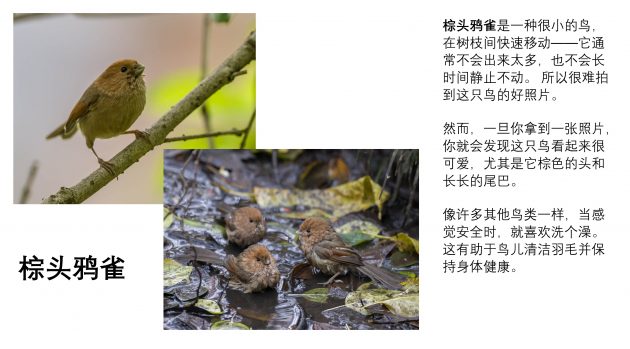
The Vinous-throated Parrotbill is quite a small bird that moves around quickly among the branches – it usually does not come out much and never stands still for long. That makes it difficult to get a good photo of the bird. Once you get a photo, though, you can see that the bird looks rather cute, with its brown head and its longish tail. Like many other birds, when it feels safe, this species likes to take a bath. This helps the bird clean its feathers and stay in good health. It also looks like the birds really enjoy doing this.
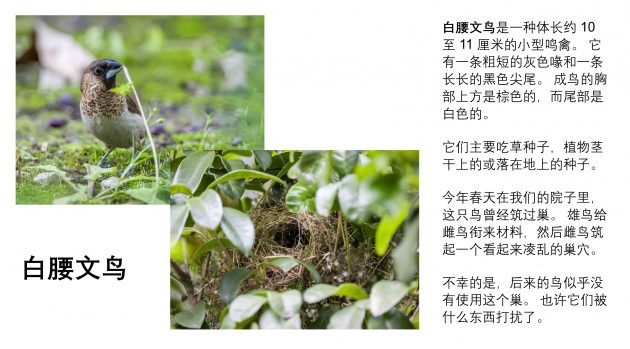
The White-rumped Munia is a small songbird approximately 10 to 11 cm in length. It has a stubby grey bill and a long black pointed tail. The adults are brown above and on the breast while the rump is white. They mainly eat grass seed, either directly from the stem or seed that has fallen on the ground. In our compound this spring, the bird was building a nest. The male bird brings the material to the female, who then builds a messy-looking nest. Unfortunately, it seems the birds later did not use this nest. Maybe they were disturbed by something.
If you are interested in the practicalities of preparing such a display, please feel free to contact me or add a comment.








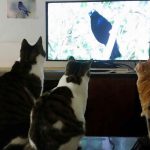




What an excellent idea! Well done!
Thanks, Clare!
Kai, I am deeply impressed! Excellent use of your consulting skills in creating presentations! I think the texts are very well written (cant judge the Chinese though), educative, and superbly localized. I wish there were more displays like yours in the world. Well done!
Thanks a lot for your nice comment, Kilian! The Chinese should basically just be a translation of the English texts unless my wife claimed some artistic liberties …
I would’ve bet I could read every single post by a German man living in China without encountering a Dave Barry quote. You really are a man of the world Kai!
Your bird photo display looks very impressive. Nice work.
Hello! I found this page while trying to figure out what the little brown things I was seeing from a distance in Shanghai and this was so lovely to see. I wish things like this were all over the city, what a wonderful way of getting kids interested in the fauna of their local neighbourhood.
Thanks, Linda!